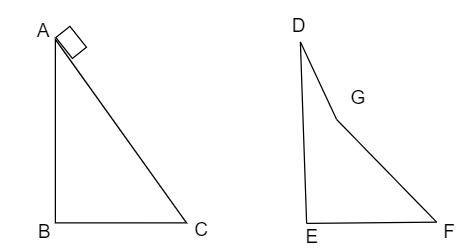
In the figure $\left( A \right)$ and $\left( B \right)$ $AC,\,DG,\,$ and $GF$ are fixed inclined planes, $BC = EF = x$ and $AB = DE = y$. A small block of mass $M$ is released from the point $A$ . It slides down $AC$ and reaches $C$ with a speed ${v_c}$ . The same block is released from rest from the point $D$ . It slides down $DGF$ and reaches the point $F$ with speed ${v_F}$ . The coefficient of kinetic frictions between the block and both the surfaces $AC$ and $DGF$ are $\mu $ . Calculate ${v_c}$ and ${v_F}$ .


Answer
559.5k+ views
Hint Analyse the diagram given in the question, and derive the equation of the motion of the block from that. Use the potential energy and the kinetic energy in it. The simplification of the above equation provides the value of the velocity of the block.
Useful formula
(1) The formula of the potential energy is given by
$P = mgh$
Where $P$ is the potential energy, $m$ is the mass of the block, $g$ is the acceleration due to gravity and $h$ is the height.
(2) The formula of the kinetic energy is given by
$K = \dfrac{1}{2}m{v^2}$
$K$ is the kinetic energy, $v$ is the velocity of motion.
Complete step by step solution
It is given that the
$AC,\,DG,\,$ and $GF$ are fixed inclined planes
$BC = EF = x$
$AB = DE = y$
The speed at which the $AC$ reaches $C$ is ${v_c}$ .
The speed at which the block slides down $AC$ and reaches $C$ is ${v_c}$
The coefficient of the kinetic friction is considered as $\mu $
It is known that the potential energy of the block is converted into the kinetic energy while moving.
$P - K = {f_2}{s_1} + {f_2}{s_2}$
Substituting the formula in it,
$mgy - \dfrac{1}{2}mv_F^2 = \mu mg\cos \beta {S_1} - \mu mg\cos \alpha {S_2}$
By simplifying the above equation, we get
${v_F} = \sqrt {2g\left( {y - \mu x} \right)} $
Note The friction affects the motion of the body when it rolls or slides down the surface. This is because the surface with the diffraction is rough and this reduces the velocity . This sliding motion is due to the acceleration due to gravity and not due to the external force applied on it.
Useful formula
(1) The formula of the potential energy is given by
$P = mgh$
Where $P$ is the potential energy, $m$ is the mass of the block, $g$ is the acceleration due to gravity and $h$ is the height.
(2) The formula of the kinetic energy is given by
$K = \dfrac{1}{2}m{v^2}$
$K$ is the kinetic energy, $v$ is the velocity of motion.
Complete step by step solution
It is given that the
$AC,\,DG,\,$ and $GF$ are fixed inclined planes
$BC = EF = x$
$AB = DE = y$
The speed at which the $AC$ reaches $C$ is ${v_c}$ .
The speed at which the block slides down $AC$ and reaches $C$ is ${v_c}$
The coefficient of the kinetic friction is considered as $\mu $
It is known that the potential energy of the block is converted into the kinetic energy while moving.
$P - K = {f_2}{s_1} + {f_2}{s_2}$
Substituting the formula in it,
$mgy - \dfrac{1}{2}mv_F^2 = \mu mg\cos \beta {S_1} - \mu mg\cos \alpha {S_2}$
By simplifying the above equation, we get
${v_F} = \sqrt {2g\left( {y - \mu x} \right)} $
Note The friction affects the motion of the body when it rolls or slides down the surface. This is because the surface with the diffraction is rough and this reduces the velocity . This sliding motion is due to the acceleration due to gravity and not due to the external force applied on it.
Recently Updated Pages
Why are manures considered better than fertilizers class 11 biology CBSE

Find the coordinates of the midpoint of the line segment class 11 maths CBSE

Distinguish between static friction limiting friction class 11 physics CBSE

The Chairman of the constituent Assembly was A Jawaharlal class 11 social science CBSE

The first National Commission on Labour NCL submitted class 11 social science CBSE

Number of all subshell of n + l 7 is A 4 B 5 C 6 D class 11 chemistry CBSE

Trending doubts
What is meant by exothermic and endothermic reactions class 11 chemistry CBSE

10 examples of friction in our daily life

One Metric ton is equal to kg A 10000 B 1000 C 100 class 11 physics CBSE

1 Quintal is equal to a 110 kg b 10 kg c 100kg d 1000 class 11 physics CBSE

Difference Between Prokaryotic Cells and Eukaryotic Cells

What are Quantum numbers Explain the quantum number class 11 chemistry CBSE




